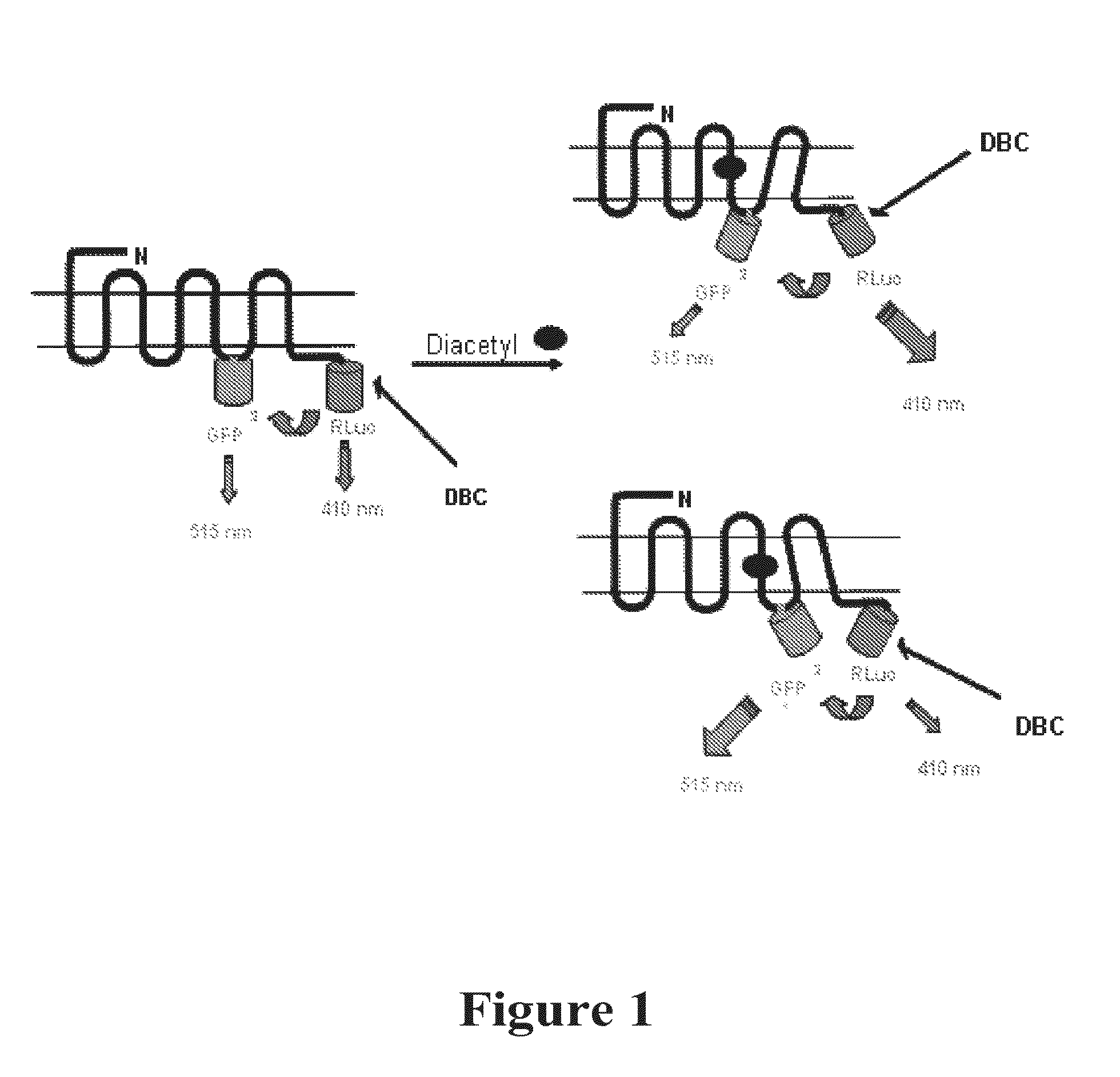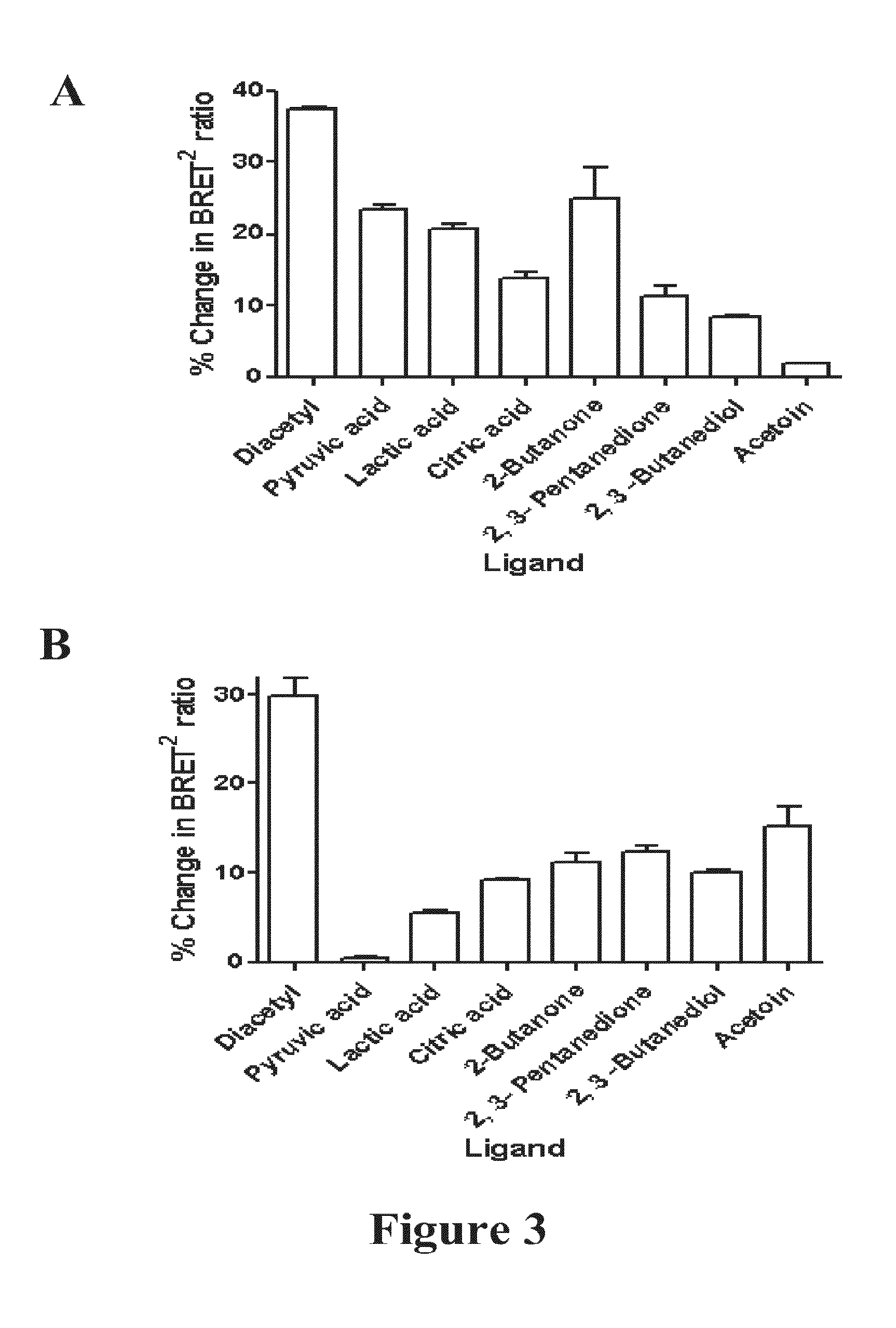Measuring G protein coupled receptor activation
a technology of g protein and activation, which is applied in the field of measuring g protein coupled receptor activation, can solve the problems of affecting the use of f1ash, and affecting the detection accuracy of g protein coupled receptors
- Summary
- Abstract
- Description
- Claims
- Application Information
AI Technical Summary
Benefits of technology
Problems solved by technology
Method used
Image
Examples
example 1
Dual Labelled Bret ODR-10 (OGPR)Constructs
Materials and Methods
Design and Construction of Dual Labelled BRET OR Constructs
[0333]BRET2 receptor constructs were generated with BRET2 components inserted into the third intracellular loop (IC3) and at the C-terminus. Two BRET constructs were made with; (1) GFP2 in the middle of IC3 and RLuc(h) on the C-terminus; (2) OR with RLuc(h) in the middle of IC3 and GFP2 on the C-terminus. The position of the third intracellular loop (IC3) was determined using TMAP on The Biology Workbench a web-based tool for prediction of transmembrane segments (http: / / seqtool.sdsc.edu). For ODR-10, the middle of the IC3 is amino acids 240-241. The amino acid sequence for this construct referred to as OGOR, is provided as SEQ ID NO:15 (encoding nucleotide sequence provided as SEQ ID NO:16).
[0334]ODR-10 was amplified from C. elegans cDNA, which was prepared with standard techniques using superscript II (Invitrogen). PCR conditions were as follows 94° C. 2 mins, 3...
example 2
Comparison of Dual-Labelled Fret ODR-10 (OCOY) To Dual-Labelled BRET2 ODR-10 (OGOR)
[0371]To compare the sensitivity of the BRET2 system to the FRET system for monitoring GPCR activation the BRET2 components used to tag the ODR-10 receptor (OGOR) were replaced with FRET components resulting in the insertion of CFP into the 3rd intracellular loop and YFP at the C-terminus (OCOY). The CFP (mCFP) (SEQ ID NO:45) and YFP (mCitrine) (SEQ ID NO:46) derivatives were both monomeric and codon optimized (EUROSCARF) for yeast expression (SEQ ID NOs 47 and 48 respectively).
Materials and Methods
[0372]The OCOY sequence flanked by KpnI and XhoI restriction sites was synthesised by Genscript. The OCOY sequence was inserted into the KpnI and XhoI sites of the pENTR11 vector. These were then recombined into pYES-DEST52 (Invitrogen) using Gateway® technology for subsequent expression in S. cerevisiae. The OCOY coding sequence is provided as SEQ ID NO:49, whereas the amino acid sequence is provided as SE...
example 3
Dual-Tagged Str112 (TGTR)
Materials and Methods
[0379]The TGTR sequence flanked by NcoI and NotI restriction sites was synthesised by Genscript. The TGTR sequence was inserted into the NcoI and NotI sites of the pENTR11 vector. These were then recombined into pYES-DEST52 (Invitrogen) using Gateway® technology for subsequent expression in S. cerevisiae.
TGTR Expression
[0380]The same expression protocol was used for the expression of TGTR in InVSC1 as for OGOR expression. The TGTR coding sequence is provided as SEQ ID NO:51, whereas the amino acid sequence is provided as SEQ ID NO:52.
RET Analysis Protocol
[0381]The same RET analysis protocol as described for the OGOR selectivity studies. 1 μM of the ligands pyruvic acid, citric acid, ethyl acetate, acetoin and diacteyl was assayed with 10 nM of TGTR
Preparation of Bacterial Extract Assays
[0382]The bacterial strain OP50 was grown in LB overnight at 37° C. with shaking (200 rpm). E. coli strain OP50 is usually used as a food source for nema...
PUM
| Property | Measurement | Unit |
|---|---|---|
| Förster distance | aaaaa | aaaaa |
| Förster distance | aaaaa | aaaaa |
| Förster distance | aaaaa | aaaaa |
Abstract
Description
Claims
Application Information
 Login to View More
Login to View More - R&D
- Intellectual Property
- Life Sciences
- Materials
- Tech Scout
- Unparalleled Data Quality
- Higher Quality Content
- 60% Fewer Hallucinations
Browse by: Latest US Patents, China's latest patents, Technical Efficacy Thesaurus, Application Domain, Technology Topic, Popular Technical Reports.
© 2025 PatSnap. All rights reserved.Legal|Privacy policy|Modern Slavery Act Transparency Statement|Sitemap|About US| Contact US: help@patsnap.com



